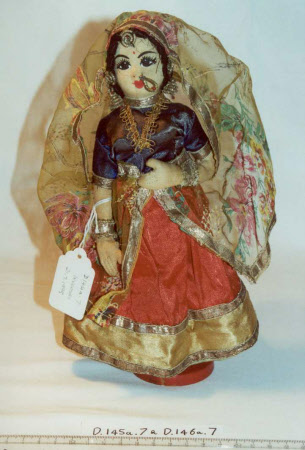Costume doll
Category
Dolls
Date
circa 1950 - circa 1976
Materials
Fabric doll
Measurements
250 mm (height)
Order this imageCollection
Sudbury Hall Museum of Childhood, Derbyshire
NT 658909
Summary
A mid-20th century national costume doll (also known as souvenir, world costume, tourist and foreign travel dolls) made to resemble an Indian bride. The doll has a moulded fabric body, head and limbs with painted facial details and bindi. Nose ring through left nostril, made from a coil of gold-coloured fine metal wire with a red bead in the centre. With black artificial hair to which are attached gold coloured coil earrings and a gold maang tikka in the centre of her forehead.The doll wears a gold embroidered uttariya (veil), attached to the waist and held in place by the arms. The choli (bodice) of a grey satin fabric with gold thread decoration. The gagra (skirt) Is of red satin fabric with a yellow and gold hem. Under the skirt are blue, grey and white fabric salwar (trousers) and green fabric shoes. One arm is positioned over the waistband and the other at the proper right side. Bangles worn on both arms, and a choker around the neck. Mounted on red wooden round base.Costume dolls representing people of different nationalities in their local dress have been made since the mid-19th century. As global travel expanded ‘world’ dolls were produced as tourist souvenirs as well as children’s toys. They appear in a variety of media, from paper to porcelain, polymer to plastic. Produced to be instantly recognisable and collectible, ‘world’ dolls can portray a stereotypical view of peoples and cultural identities.
Provenance
One doll from a collection of costume dolls donated by Mr R.T. Macfarlane in 1976.
